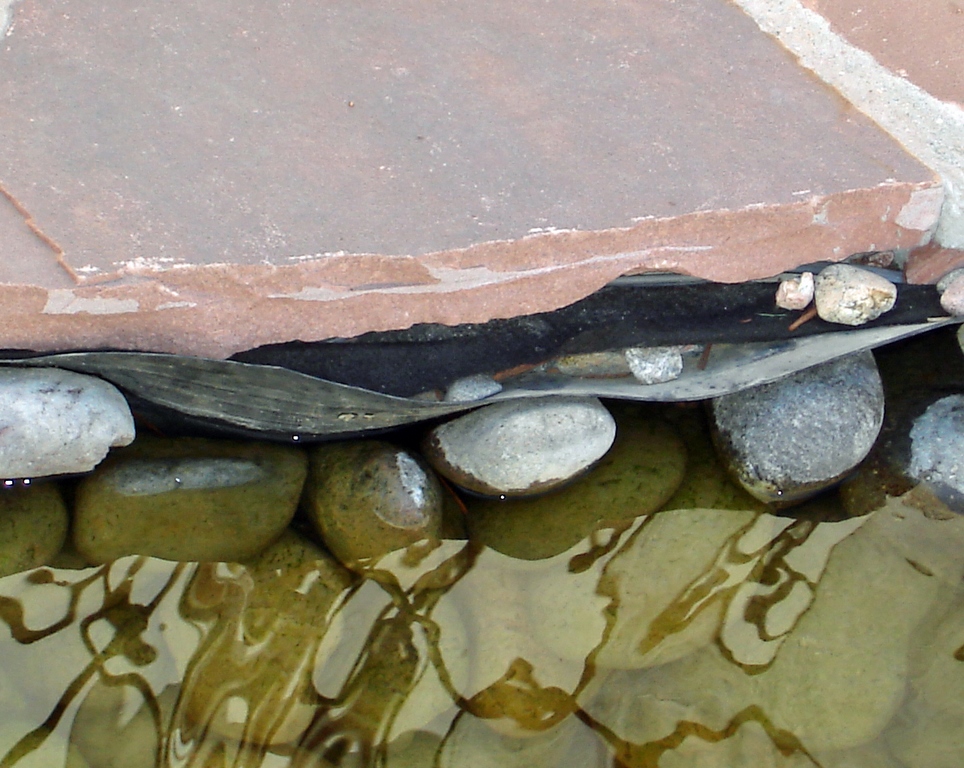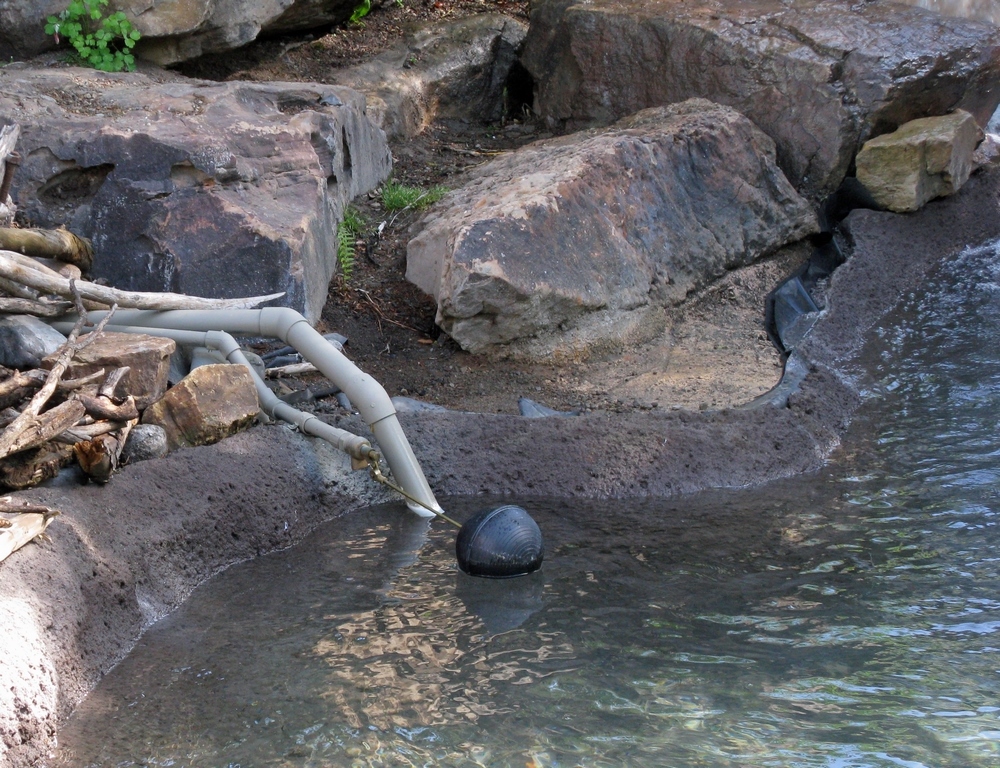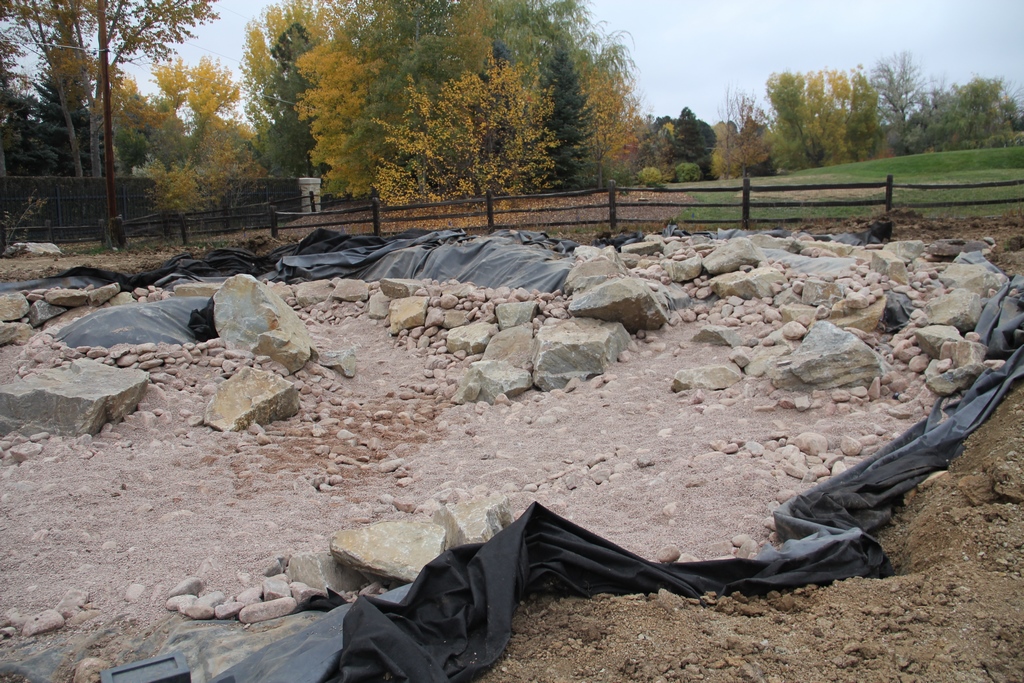Your Liner Is Showing

I’m not crabby by nature – just the opposite, in fact – and I don’t want anyone to think that I go out of my way to find and critique flawed ponds.
Thing is, I’m a reputable pond designer and installer and have made a point through the years of meeting with garden clubs and other groups that are interested in what pond-making is all about. After these events, it hasn’t been uncommon for owners of ponds installed by others to call me over for a visit and ask me what I think needs to be done to address what they see as worrisome aesthetic or functional problems.
These encounters don’t upset me as much as they make me sad. But there’s a positive here in that these incidents have inspired me to work up this series of articles, in which I’ve been addressing problems I’ve come across most frequently in hopes of raising consciousness about them and helping other pond people sidestep certain problems before they ever occur.
In that sense, I’m here as an advocate for clear-eyed homeowners who perceive the difference between something that looks natural and operates well and something that fails on both fronts. This time, join me as I look at the aesthetics of liners and start by declaring they should never, ever be seen in a pond. Ever.
Moveable Beasts
Quite often, I’m contacted by homeowners who have become frustrated by a distressing transformation: A pond that once looked quite natural now has a shoreline defined by a fully exposed liner where rocks and pebbles and gravel and plants once took center stage.
The decline has happened gradually, they tell me, and didn’t really become noticeable until the pond was a couple years old. It’s simple, I tell them: The freeze/thaw conditions we experience in the Denver area make things move every winter and spring, and that movement has made the rocks that once covered the edge of the liner migrate off the bank and drop into the pond or even settle back into the landscape.
| This is clearly a case (at left) where frost heave has dumped rocks into the pond from their former perches along the edge and has put the liner on public view. (It’s also a case where the shoreline configuration looks as though it was doomed to fail in precisely this way and could stand to be reshaped as something other than a speed bump.) But liner exposure is occasionally much more subtle: The flash of material seen at right has been revealed by settlement of large rocks over a harsh winter and really just needs to be hidden again. |
The trouble here, of course, is that the original installers didn’t account for this omnipresent fact of cold-climate life and failed to do an adequate job of locking their rockwork into place. With the heaving of a winter or two or three, liners emerge and are seen by pond owners for the first time – and all they know is that their ponds just don’t look the same. It’s a situation that is neither good nor acceptable.
Of course, frost heave isn’t always the culprit: Poorly set rocks can easily be shifted by deer, bears and other large animals that come to visit and carelessly plop their hooves or paws on poorly secured stonework. Lots of installers will set up great, steady, sturdy places for humans to stand to feed their fish, but the rest of the perimeter? No such luck – and that’s how animals create little avalanches that can expose a liner.
| This installation has problems that go well beyond the exposed section of liner, but let’s overlook the toilet-tank water leveler and the generally failed pursuit of a ‘naturalistic’ look to focus on the fact that the liner should have extended well past the boulders and up into the landscape. |
There’s also the common problem that results from using too little rock material atop the liner: A thin veneer of small stones, pebbles or gravel can make it possible even for feeding fish to move things around enough to expose sections of liner both above and below the waterline.
The point is, none of these installation errors should happen: Every pond installer should take the time to select, place and lock in rocks in such a way that they will not move easily, regardless of the liner-exposing challenges the pond potentially faces. Exposed liner is unsightly, for starters, but it is also subject to degradation in sunlight as ultraviolet radiation causes the material to lose its flexibility and ultimately become brittle.
Another option, of course – and one I use and recommend highly – involves visiting your old projects periodically and committing yourself to addressing situations like these as they arise and before greater damage occurs. It’s great customer service, and the right thing to do, too!
So know your local conditions – whether it’s freezing and thawing in Denver or minor earthquakes in Los Angeles – and approach the tasks at hand with the thought that good work lasts and makes pond owners happy for the long haul. And of course, these cheerful homeowners will never need to call me to explain what’s gone wrong, which’ll have the added benefit of leaving me smiling instead of frowning!
Liner Health
One of the operations in which I exercise the greatest level of on-site supervision is in laying out liners – especially big ones. Although these sheets are incredibly tough, if they’re mishandled while being moved into position, the result can be pinpricks and small tears that can be difficult to find after the client calls to report a leak.
| With their underlying rocks and roots, most pond sites are hazardous environments for liners. It’s just good practice to be conscientious about protecting them during installation – and making certain they’re large enough to reach well beyond the blue space drawn up in a sketch or rendering. |
We always use a geotextile underlayment as a first line of protection, but that’s often not enough unless you’re working in, say, fine sand. So once the underlayment is placed, we’ll walk the entire space looking carefully for any protrusion or rocky edge or root that might pose a threat and will deal with each accordingly, sometimes with a bit of digging, but other times by adding extra layers of protective fabric.
We also aim in our projects to include plenty of excess liner we can work with beyond our shorelines, streams and waterfalls. A stream, for instance, might flow along a course two feet wide – but we’ll use a ten-foot width of liner beneath it. After setting our stones, we’ll roll the excess liner up behind the rockwork and cover it with gravel, an exercise that keeps it supple enough that we can make small adjustments with rock placements much later on without too much trouble.
| Even in formal ponds (left), it’s always good practice to use plenty of material to give the liner the ability to stretch under pressure without tearing. Even more wrinkles and rumples are required for the naturalistic stream/cascade shown at right: Here, although the water’s path will ultimately be only a few feet wide, the liner extends past the flow by several feet in both directions to keep the water where it belongs while giving the material stretching room beneath boulders that will definitely move and settle as the years pass. |
What this requires is careful positioning of the liner when it’s first put into place: Once it’s unrolled – and we always try to work with single pieces rather than having to seam smaller pieces together – it can be cumbersome to move the mass over by even a few inches or feet to provide the desired margins. And every such shift opens the possibility of dragging the liner across some unnoticed protrusion that will cut into the material like a serrated knife.
One last thing: When I started in the pond business, I pulled liners taut across the surfaces I was covering – a practice I discontinued many, many years ago. In fact, I like leaving substantial folds and rumples because they give the liner a chance to make long term adjustments as big rocks settle. Without some slack, the liner will fail under pressure – another potential frown I prefer to turn upside-sown.
Next time: The proper care and feeding of pond foam.
Dave Garton, owner of Lawnchair Watershapes in Denver, is an expert pond and stream builder as well as an in-demand business speaker and coach. He may be reached at [email protected].
















